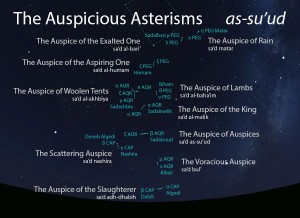Elements of the Celestial Complex
The Auspice of the Slaughterer (sa’d adh-dhabih, سعد الذابح)
The Sheep (ash-shat, الشاة)
The Voracious Auspice (sa’d bul’, سعد بلع)
The Scattering Auspice (sa’d nashira, سعد ناشرة)
The Auspice of Auspices (sa’d as-su’ud, سعد السعود)
The Auspice of the King (sa’d al-malik, سعد الملك)
The Auspice of Lambs (sa’d al-baha’im, سعد البهائم)
The Auspice of Woolen Tents (sa’d al-akhbiya, سعد الأخبية)
The Auspice of the Aspiring One (sa’d al-humam, سعد الهمام)
The Auspice of the Exalted One (sa’d al-bari’, سعد البارع)
The Auspice of Rain (sa’d matar, سعد مطر)
The ten Auspicious Asterisms are all pairs of otherwise unremarkable stars, except for one that is comprised of four stars. The Arabic term sa’d indicates good fortune or something that is auspicious, especially a star. All located within the same region of sky, the Auspicious Asterisms begin to set just before the Two Vultures (an-nasran) set. When the calendar of lunar stations was generated, the pre-existing Auspicious Asterisms that were located closest to the Moon’s path were incorporated as lunar stations.

The Auspicious Asterisms (as-su’ud) as they appear setting in the west about 45 minutes before sunrise in early August. Sky simulations made with Stellarium.
Appearance
The ten Auspicious Asterisms are all pairs of otherwise unremarkable stars, except for one that is comprised of four stars.
Modern Identification
α CAP (Algedi), orange and yellow double star, magnitudes 3.6 and 4.2
β CAP (Dabih), yellow and blue double star, magnitudes 3.7 and 6.0
ν CAP (Alshat), blue-white star, magnitude 4.8
ε AQR (Albali), white star, magnitude 3.8
μ AQR, yellow-white star, magnitude 4.7
γ CAP (Nashira), white star, magnitude 3.7
δ CAP (Deneb Algedi), white star, magnitude 2.9
β AQR (Sadalsuud), yellow supergiant star, magnitude 2.9
ξ AQR, white star, magnitude 4.7
α AQR (Sadalmelik), yellow supergiant star, magnitude 3.0
ο AQR, blue star, magnitude 4.7
θ PEG (Biham), blue-white star, magnitude 3.5
ν PEG, yellow star, magnitude 4.9
γ AQR (Sadachbia), white star, magnitude 3.8
π AQR, blue-white star, magnitude 4.8
ζ AQR, white double star, magnitudes 4.3 and 4.5
η AQR, blue-white star, magnitude 4.0
ζ PEG (Homam), blue-white star, magnitude 3.4
ξ PEG, white star, magnitude 4.2
μ PEG (Sadalbari), yellow-white star, magnitude 3.5
λ PEG, yellow-white star, magnitude 4.0
η PEG (Matar), yellow giant star, magnitude 2.9
ο PEG, blue-white star, magnitude 4.8
Timing
The entire set of ten Auspicious Asterisms rise within about a month but set over the course of two months. Today we can expect to observe the Auspicious Asterisms setting in the west (about 45-60 minutes before sunrise) from early August through early October, as seen from the latitude of Tucson. Likewise, they rise from early February through early March.
Rain Stars
The Auspicious Asterisms do not figure in the calendar of the rains stars.
Lunar Stations
The celestial complex of the Auspicious Asterisms comprises four lunar stations. The earliest listings of the lunar stations were later adjusted backwards by two stations to adjust the calendar to begin with the vernal equinox. In what follows below, the earlier order is listed in parentheses.
22nd (24th) lunar station: The Auspice of the Slaughterer (sa’d adh-dhabih)
23rd (25th) lunar station: The Voracious Auspice (sa’d bul’)
24th (26th) lunar station: The Auspice of Auspices (sa’d as-su’ud)
25th (27th) lunar station: The Auspice of Woolen Tents (sa’d akhbiya)

